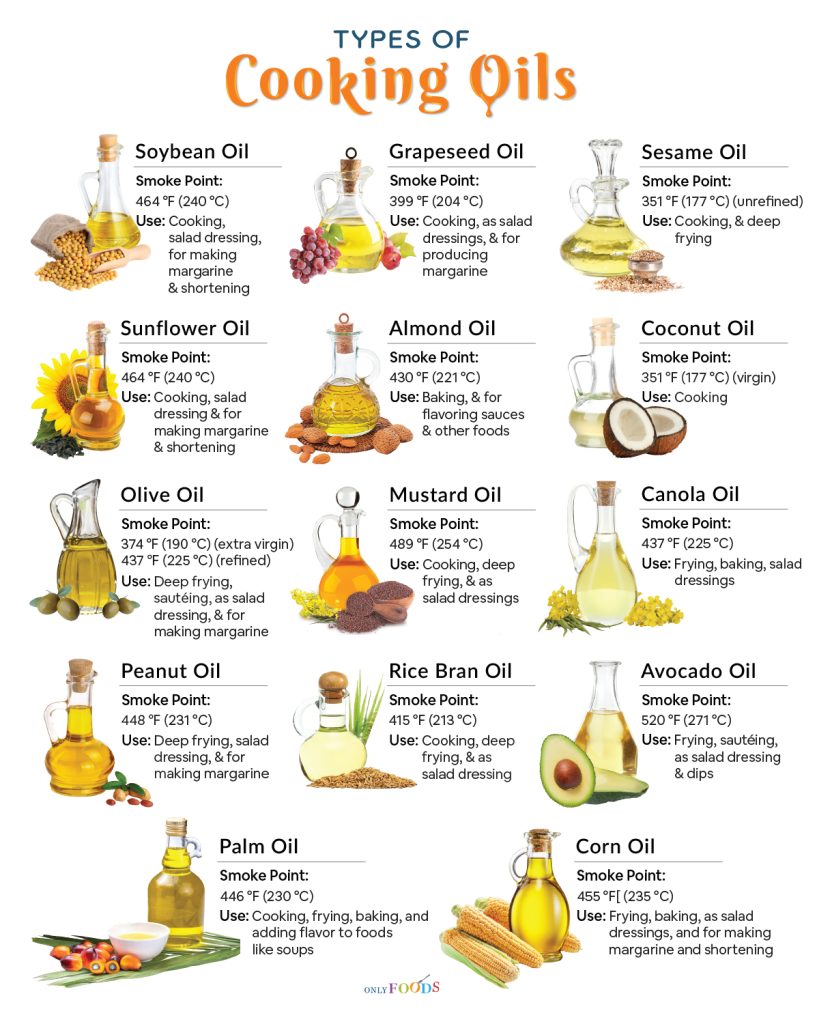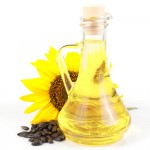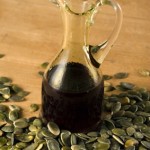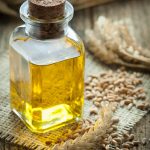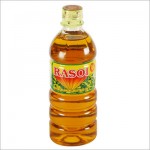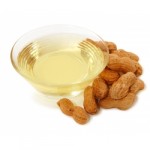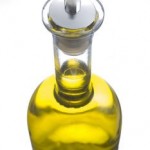Oils
Almost all types of plants, especially their seeds, contain oils. These oils are extracted using various methods for numerous edible and non-edible purposes. The edible vegetable oils contain 4 main types of fats – polyunsaturated, monounsaturated, saturated, and trans fat. The first 2 kinds of fats are healthy for the human body, while the latter two are unhealthy. So, the fat content of vegetable oils decides their nutritional value.
Another consideration to decide on an oil’s use for cooking is its smoke point. Oils with high smoke points can withstand higher temperatures while maintaining stability, making them suitable for high-heat cooking and baking. An oil’s nutrient content and taste are affected when heated beyond its smoke point.
List of the Most Common Vegetable Oils Used for Cooking (With Smoke Points)
| Name of Oil | Smoke Point | Commonly Used for |
| Olive Oil | 374 °F (190 °C) (extra virgin)
419 °F (215 °C) (virgin) 437 °F (225 °C) (refined) 468 °F (242 °C) (extra light) |
Deep frying, sautéing, stir-frying, and as salad dressing; also for producing margarine |
| Sunflower Oil | 471 °F (244 °C) (high oleic, refined)
464 °F (240 °C) (linoleic, refined) 412 °F (211 °C) (mid-oleic, refined) |
Cooking, salad dressing and for producing margarine and shortening |
| Almond Oil | 430 °F (221 °C) | Baking, and for flavoring sauces and other foods |
| Avocado Oil | 520 °F (271 °C) | Frying, sautéing, and as salad dressing and dips |
| Coconut Oil | 351 °F (177 °C) (virgin) | Cooking |
| Rice Bran Oil | 415 °F (213 °C) | Cooking, deep frying, and as salad dressing |
| Soybean Oil | 464 °F (240 °C) | Cooking, salad dressing, and for producing margarine and shortening |
| Canola Oil (An edible variety of rapeseed oil) | 437 °F (225 °C) | Frying, baking, salad dressings. Regulations on edible uses in the UK due to high erucic acid levels |
| Peanut Oil (Groundnut Oil) | 448 °F (231 °C) | Frying, deep frying, and as salad oil; also for producing margarine |
| Sesame Oil | 351 °F (177 °C) (unrefined)
450 °F (232 °C) (semi-refined) |
Cooking, and deep frying |
| Macadamia Oil | 410 °F (210 °C) | Frying, deep frying, and as salad dressings |
| Corn Oil | 455 °F[ (235 °C) | Frying, baking, as salad dressings, and for producing margarine and shortening |
| Grapeseed Oil | 399 °F (204 °C) | Cooking, as salad dressings, and for producing margarine |
| Palm Oil | 446 °F (230 °C) | Cooking, frying, baking, and adding flavor to foods like soups |
| Mustard Oil (Pressed) | 489 °F (254 °C) | Cooking, deep frying, and as salad dressings. Mainly used in Indian cuisine. Not approved by the FDA due to high erucic acid levels, and banned in the US for edible purposes. |
| Safflower Oil | 468 °F (242 °C) (high oleic)
468 °F (242 °C) (linoleic) |
Cooking, frying, and as salad dressing |
| Tea Seed Oil | 486 °F (252 °C) | Cooking, stir-frying, as salad dressing, and for producing margarine |
More Types of Edible Oils Often Used for Cooking
- Hazelnut Oil
- Cashew Oil
- Poppyseed Oil
- Pistachio Oil
- Cottonseed Oil
- Brazil Nut Oil
- Corn Oil
- Macadamia Oil
- Pecan Oil
- Pumpkin Seed Oil
- Bottle Gourd Oil
- Butternut Squash Seed Oil
- Jamaican Cobnut Oil
- Beech-nut Oil
- Mongongo Nut Oil (Manketti Oil)
- Cohune Oil
- Prune Kernel Oil
- Tigernut Oil (Nut-sedge Oil)
- Watermelon Seed Oil (Used as a cooking oil primarily in West Africa)
- Pequi Oil (Highly valued as a cooking oil in Brazil)
- Sapote Oil (Used as a cooking oil primarily in Guatemala)
- Tomato Seed Oil (Used as a cooking oil primarily in China)
Animal fats such as butter, ghee (clarified butter), and lard (pork fat) are other cooking fats widely used worldwide.
Additionally, many vegetable oils are unsuitable for cooking or frying due to their low smoke point. These include oils extracted from pumpkin seed, flaxseed, hemp seed, cottonseed, walnut, and pine nut. These oils’ rich flavor and texture make them useful as salad dressings and enhance the flavor of soups and sauces.

